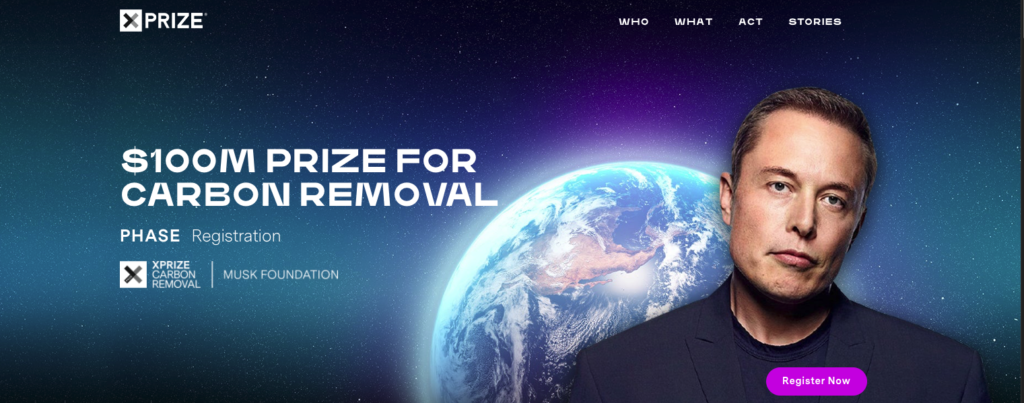X-Prize Gigaton Challenge

What is the Goal and Why?
"The climate math is becoming clear that we will need gigaton-scale carbon removal in the coming decades to avoid the worst effects of climate change. The International Panel on Climate Change (IPCC) estimates the need at approximately 10 gigatonnes of net CO2 removal per year by the year 2050 in order to keep global temperature rise under 1.5 or 2C. As governments, companies, investors, and entrepreneurs make plans to meet this challenge, it is clear that we will need a range of carbon removal solutions to be proven through demonstration and deployment to complement work that is already underway. If humanity continues on a business-as-usual path, the global average temperature could increase 6˚(C) by the year 2100.
This four-year global competition invites innovators and teams from anywhere on the planet to create and demonstrate solutions that can pull carbon dioxide directly from the atmosphere or oceans, and sequester it durably and sustainably. To win the grand prize, teams must demonstrate a working solution at a scale of at least 1000 tonnes removed per year; model their costs at a scale of 1 million tonnes per year; and show a pathway to achieving a scale of gigatonnes per year in future.
How to Win?
To win the prize teams must demonstrate CO2 removal at the 1000 tonne per year scale, model costs at the million ton per year (megatonne) scale, and present a plan to sustainably reach gigatonne per year scale in future. In the first phase of the competition, teams must demonstrate the key component of their carbon removal solution, at a minimum.
Any carbon negative solution is eligible: nature-based, direct air capture, oceans, mineralization, or anything else that achieves net negative emissions, sequesters CO2 durably, and show a sustainable path to achieving low cost at gigatonne scale.

Goals in Perspective
1 Gigaton is one billion tons = 1,000 million tons of CO2
BEAM has been proven to add over 10 metric tons of carbon per hectare (2.5 acres) to the soil every year
The process of plant photosynthesis removes and uses 3.67 tons of CO2 from the atmosphere for every ton of carbon added to the soil.
With BEAM 10 metric tons of carbon therefore represent 36.7 tons of CO2 removed from the atmosphere per hectare per year. (With intensive adaptive rotational grazing with cows the amount of carbon dioxide removed is increased to approximately 70 tons per hectare/year)
-
Therefore: if BEAM is used, it will require 27.25 hectares (68 acres)(259 hectares in one square mile) to remove one thousand (1,000) tons of CO2 per year.
-
It will require 27,250 hectares to remove one million (1,000,000) tons of CO2 per year.
-
It will require 27,250,000 hectares to remove one Gigaton ( One Billion - 1,000,000,000) tons of CO2 per year. (The UN recommends removing 10 Gigaton of CO2/year to alleviate 'climate change' so it with even modest usage of the BEAM process this can easily be obtained!)
BEAM usage recommendations are 1-2 kg/hectare (1-2 pounds/acre). Using 1-2kg of BEAM results in removing 36 tons (36,000kg.) of CO2. 1-2 kg of BEAM has a multiplier effect of 36,000 kg of CO2 removal!
No other 'solution' for removing CO2 even comes close! And the some of the benefits of this process, in addition to CO2 removal and carbon sequestration in the soil are:
BEAM Benefits
Improves germination and growth rates
Increase crop yields 50-100% or more
Improve water infiltration and retention
Better soil nutrient availability
Increases soil carbon sequestration
Decreased need for fertilizer
Reduces water usage up to 6 times
Dr. Johnson believes that this method of regenerating the soils holds the most promise for carbon sequestration tested.

